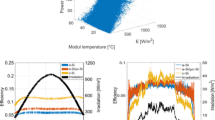Abstract
Textured crystalline silicon solar cells, planar crystalline silicon solar cells, textured glass, and planar glass are commonly fabricated for crystalline silicon solar modules. Thus, there are four kinds of crystalline silicon solar modules. The photovoltaic electricity outputs of these four kinds of modules with the same peak power are different under true sunshine conditions. This discrepancy inevitably occurs due to the different materials used in modules. Using the actual optical performance of a four-layer encapsulation, a simulation was made on the reflection losses and energy outputs of the four kinds of solar modules. The computer simulation shows that the module encapsulated by textured crystalline silicon solar cells and textured glass has more energy output than others in actual uses. Even if they have equal electrical characteristics under standard test conditions of 1000 W/m2, 25°C cell temperature, and 1.5 air mass, the result of simulation approximately agrees with the measured values. A quantitative analysis of energy production of the four kinds of modules with the same peak power as a function of angle of incidence and module structure is presented for the first time. Performing the measured energy production analysis for the four kinds of modules with the same peak power as a function of angle of incidence and module structure provides insight into economic analysis of PV systems and performance estimation of a photovoltaic roof within a fixed flat plate array.








Similar content being viewed by others
References
Lakhtakia A, Ashok S (1997) Analysis of textured surfaces for photovoltaics. Sol Energy Mater Sol Cells 46:137–146
Lasnier F, Ang TG (1990) Photovoltaic engineering handbook. IOP Publishing Ltd., London, pp 358–370
Maddalenaa P, Parrettab A et al (2008) Simultaneous optical losses and current measurements in photovoltaic devices at variable angle of the incident light. Sol Energy Mater Sol Cells 75:397–404
Nakamura H, Yamada T et al (2007) Data analysis on solar irradiance and performance characteristics of solar modules with a test facility of various tilted angles and directions. Sol Energy Mater Sol Cells 67:591–600
Wang He, Yang Hong et al (2003) Influence of gettering and passivation on uniformity of the electrical parameters in monolithic multicrystalline silicon solar cell. Solid State Electron 47:1363–1367
Yamada T, Nakamura H et al (2001) Reflection loss analysis by optical modeling of PV module. Sol Energy Mater Sol Cells 67:405–413
Yang Hong, Wang He et al (2003) Status of photovoltaic industry in China. Energy Policy 31(8):703–707
Acknowledgments
The authors would like to thank the support of Bureau of Science and Technolgy under the project no. CXY 1021 and fund of Applied Materials Co. under the project No. XA-AM-200901 and 201005. Prof. Rongqiang Cui of Research Institute of Solar Energy, Shanghai Jiaotong University, provided extensive consultation throughout the course of this work.
Author information
Authors and Affiliations
Corresponding author
Rights and permissions
About this article
Cite this article
Yang, H., Wang, H. Performance analysis of crystalline silicon solar modules with the same peak power and the different structure. Clean Techn Environ Policy 13, 527–533 (2011). https://doi.org/10.1007/s10098-010-0335-z
Received:
Accepted:
Published:
Issue Date:
DOI: https://doi.org/10.1007/s10098-010-0335-z




